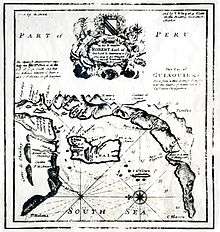John Clipperton
| John Clipperton | |
|---|---|
| Born |
1676 Great Yarmouth, Norfolk, England |
| Died |
June 1722 (aged 45/46) Galway, Ireland |
| Nationality | English |
| Occupation | Privateer |
| Known for | Namesake of Clipperton Island |
John Clipperton (1676 – June 1722) was an English privateer who fought against the Spanish in the 18th century. He was involved in two buccaneering expeditions to the South Pacific—the first led by William Dampier in 1703, and the second under his own command in 1719. He used Clipperton Island as a base for his raids on the Spanish Main.
Early life and personality
John Clipperton was born in Great Yarmouth, Norfolk, in 1676 into a family of seafarers. In his younger days he sailed all the seas of Europe, made one trip to the West Indies and one around the world. He was an able pilot and seaman, but also a man of faults. He was a blunt, plain-spoken sailor. He was definitely no gentleman; but at times tried to be seen as one. Rash fits of rage would befall him, although he was soon appeased. Then he would be ready to repair any injustice that he had committed in the heat of anger—at least when this was possible.
Privateering voyage with Dampier

In 1703 he sailed with the expedition of Captain William Dampier during the War of the Spanish Succession. Dampier appointed Clipperton captain of one of the Spanish ships they had taken as a prize. This first voyage of Clipperton did not proceed well. He led a mutiny against Dampier, and was later taken captive by the Spanish. The Marquis de Villa-Rocha, who would subsequently become governor of Panama, treated him with much indifference. Clipperton returned home in 1712 after four years of captivity.
It was, however, during this journey that he is said to have discovered Clipperton Island, which he would use as a hideout. He would later become captain of the Success as part of a different privateering syndicate, in which he also held under his nominal command Captain George Shelvocke of the Speedwell. In his activities attacking Spanish targets on the west coast of the Americas, he used Clipperton Island as a base from which to stage his attacks and store loot and supplies, fortifying Clipperton Rock and expanding its cave network.
Later privateering expedition
Much more is known about Clipperton's second voyage to the Pacific Ocean in 1719. By that time he had become an able and diligent captain, but he was still unable to control his rash temper. In 1718 a group of London merchants, the "Gentleman Venturers", had financed a privateering expedition in expectation of the outbreak of the War of the Quadruple Alliance, with a commission to cruise against the Spanish in the South Sea. Clipperton in the Success sailed with the Speedwell, captained by George Shelvocke. Clipperton had replaced Shelvocke as overall commander of the expedition before the two ships left Plymouth in February 1719.
The ships lost contact with each other shortly after during a storm in the Bay of Biscay and did not meet up again until nearly two years later in the Pacific. On the voyage around Cape Horn, Clipperton dallied in the islands there hoping that Speedwell, which had been separated from Success in the storm, would catch up. When the Success departed the area, Clipperton left two men marooned as punishment on Juan Fernández, which Alexander Selkirk (who may have partly inspired the Robinson Crusoe story) had been marooned on years before.
Clipperton sailed right around South America, raiding Spanish shipping about the coasts of Perú at the so-called "Southern Seas", where he was chased by Spanish admiral Blas de Lezo during the latter's first safety operations in the area. The privateer managed to escape Blas de Lezo and finally fled to Asian shores, where he was taken for dead. He captured his old enemy the Marquis de Villa-Rocha, whom he treated with much respect. Later, his travels carried him to Mexico and to Macau, where he stayed as his health deteriorated. He then sailed to Batavia (now Jakarta) in the Dutch East Indies, finally returning to his family in Galway in Ireland in June 1722. He died a week after returning home.
References
- Skaggs, Jimmy M. (1989). Clipperton: A History of the Island the World Forgot. New York: Walker & Co. ISBN 978-080-27-1090-1.